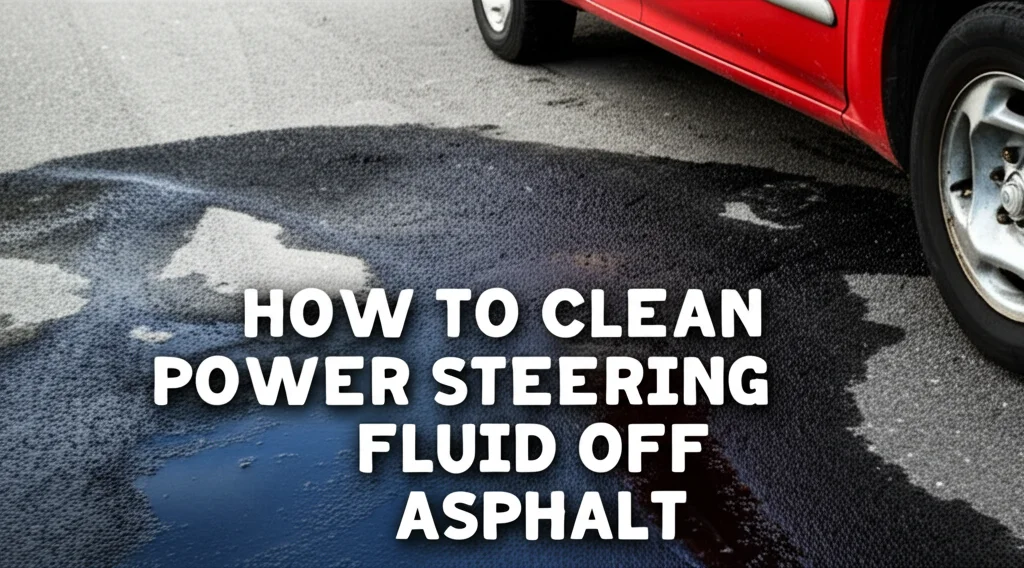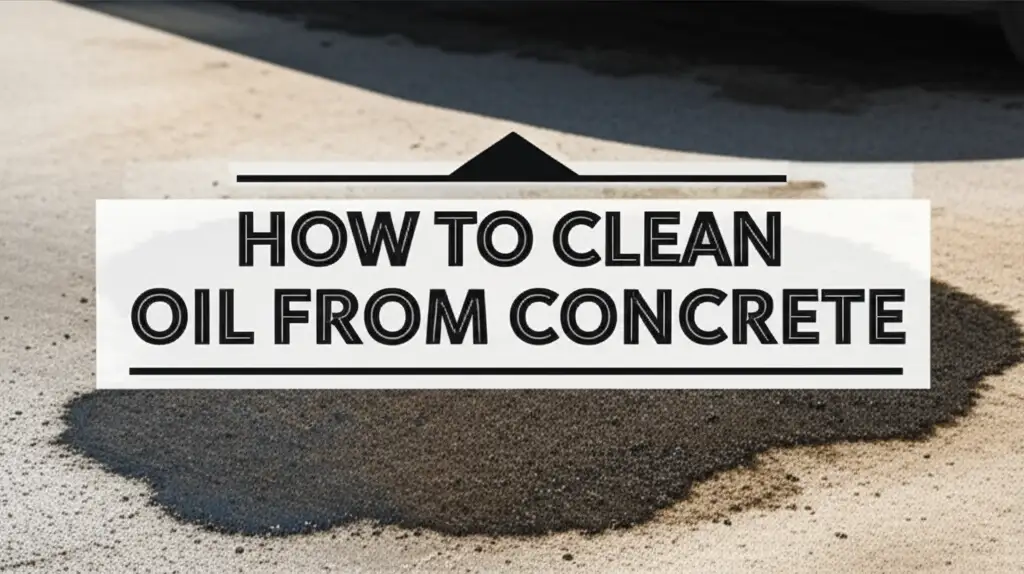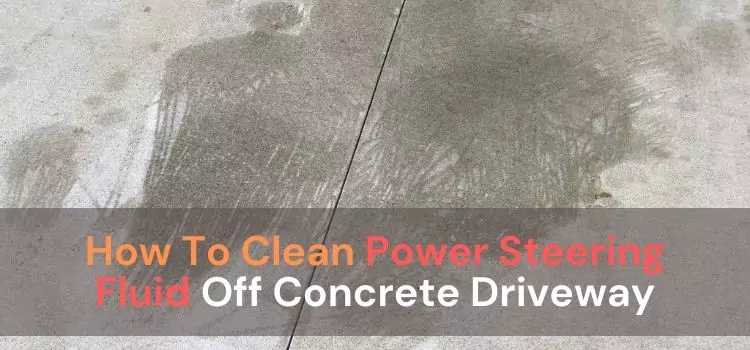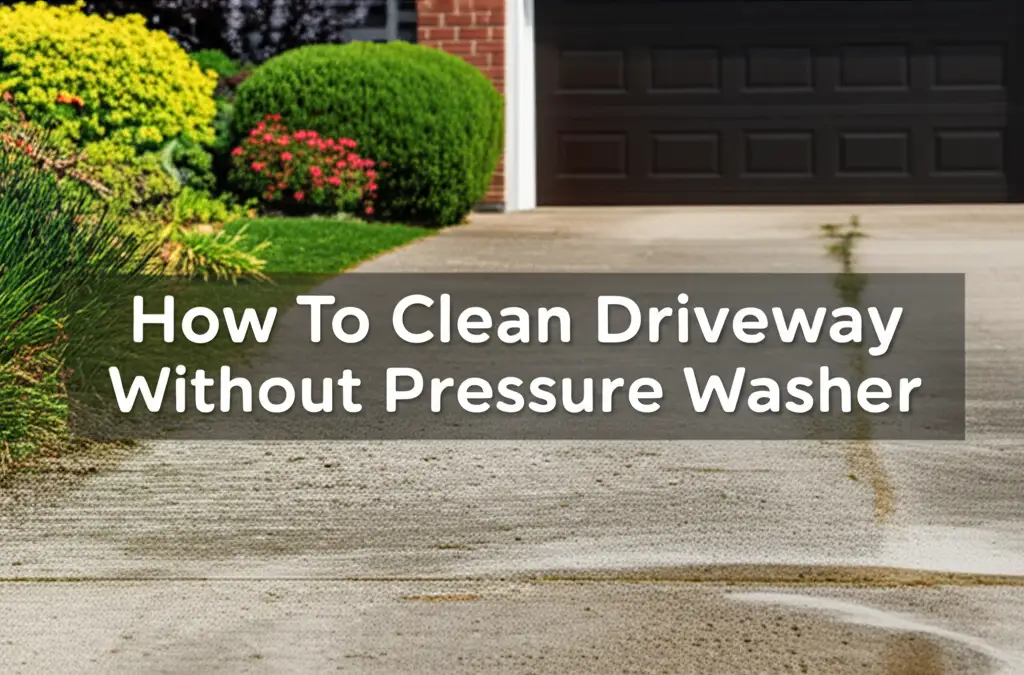· Auto & Home Cleaning · 7 min read
How To Clean Power Steering Fluid Off Asphalt

Power Steering Fluid on Asphalt? Here’s How to Clean It Up
Have you just discovered a puddle of power steering fluid staining your asphalt driveway? Don’t panic! Power steering fluid is a hydraulic fluid, and while it’s messy and can damage asphalt over time, it can be cleaned up. This guide will walk you through the best methods to remove power steering fluid from asphalt, protecting your driveway and the environment. We’ll cover everything from immediate absorption to deep cleaning with degreasers, ensuring a spotless finish. Let’s get started and restore your asphalt to its original condition.
Takeaway:
- Act Fast: The quicker you address the spill, the easier it will be to clean.
- Absorb First: Use absorbent materials like kitty litter or cornstarch to soak up the bulk of the fluid.
- Degrease & Scrub: Follow up with a degreaser and a stiff brush to remove remaining residue.
- Rinse Thoroughly: Ensure all cleaning products are rinsed away to prevent further damage.
Quick Answer:
To clean power steering fluid off asphalt, first absorb as much liquid as possible with kitty litter or cornstarch. Then, apply a degreaser specifically designed for automotive fluids, scrub vigorously with a stiff brush, and rinse thoroughly with water.
Understanding the Problem: Why Clean Power Steering Fluid?
Power steering fluid isn’t just unsightly; it’s also harmful to your asphalt. This fluid contains chemicals that can break down the asphalt binder, leading to softening, cracking, and eventual deterioration. Ignoring a spill can result in costly repairs down the road. Furthermore, power steering fluid is environmentally unfriendly and can contaminate soil and groundwater if left unchecked. Prompt cleanup is crucial for both the longevity of your driveway and the health of the surrounding environment. It’s a slippery hazard too, so removing it quickly improves safety.
Immediate Action: Absorbing the Spill
The first step in cleaning up power steering fluid is to absorb as much of it as possible. Time is of the essence here, as the longer the fluid sits, the deeper it penetrates the asphalt. Here’s what you’ll need:
- Absorbent Material: Kitty litter (clay-based, not clumping), cornstarch, or even sawdust work well.
- Gloves: Protect your hands from direct contact with the fluid.
- Shovel or Broom: For spreading and collecting the absorbent material.
Simply pour a generous amount of your chosen absorbent material over the spill, ensuring it completely covers the affected area. Let it sit for at least 30 minutes, or even longer for larger spills, allowing the absorbent to soak up the fluid. Once saturated, sweep or shovel up the used absorbent and dispose of it properly – check your local regulations for hazardous waste disposal. Don’t just throw it in the trash!
Choosing the Right Degreaser for Asphalt
After absorbing the bulk of the fluid, you’ll likely still have a stain and some residue left behind. This is where a degreaser comes in. However, not all degreasers are created equal, and using the wrong one can actually damage your asphalt. Here’s what to look for:
- Asphalt-Safe Formula: Specifically look for degreasers labeled as safe for asphalt or concrete.
- Automotive Degreaser: These are formulated to break down automotive fluids like power steering fluid.
- Biodegradable Options: Consider environmentally friendly, biodegradable degreasers.
Avoid harsh chemicals like strong solvents or acids, as these can dissolve the asphalt itself. A good option is a citrus-based degreaser, which is effective at cutting through grease and oil without being overly harsh. You can find these at most auto parts stores or home improvement centers. Always read and follow the manufacturer’s instructions on the degreaser label.
The Scrubbing Process: Removing Stubborn Residue
Once you’ve applied the degreaser, it’s time to get scrubbing! This is where some elbow grease comes in handy. You’ll need:
- Stiff-Bristled Brush: A deck brush or scrub brush works best. Avoid metal brushes, as they can scratch the asphalt.
- Water Hose: For rinsing.
- Gloves & Eye Protection: Protect yourself from splashes.
Apply the degreaser according to the product instructions, typically letting it sit for 5-10 minutes to break down the residue. Then, using the stiff-bristled brush, scrub the affected area vigorously in a circular motion. Apply firm pressure, but avoid excessive force that could damage the asphalt. For particularly stubborn stains, you may need to repeat the degreasing and scrubbing process. Consider working in sections to ensure thorough cleaning.
Rinsing and Final Inspection
After scrubbing, it’s crucial to rinse the area thoroughly with water. This removes the degreaser and any remaining residue. Use a garden hose with a nozzle to create a strong stream of water.
- Rinse Completely: Ensure all traces of the degreaser are washed away.
- Check for Remaining Stains: Inspect the area closely for any lingering stains.
- Repeat if Necessary: If stains persist, repeat the degreasing and scrubbing process.
Allow the asphalt to dry completely before driving or walking on it. A final inspection will ensure you’ve removed all traces of the power steering fluid and restored your driveway’s appearance. If you’re still seeing a faint stain, consider a second application of degreaser and scrubbing.
Preventing Future Spills and Maintaining Asphalt
Prevention is always better than cure. Here are a few tips to prevent future power steering fluid spills and maintain the health of your asphalt:
- Regular Vehicle Maintenance: Address any leaks in your power steering system promptly.
- Drip Pans: Use drip pans under your vehicle when performing maintenance.
- Sealcoating: Apply a sealcoat to your asphalt driveway every 2-3 years to protect it from damage and extend its lifespan. You can learn more about sealcoating at https://www.beacleaner.com/how-to-clean-hardwood-floors-with-vinegar/.
- Prompt Cleanup: If a spill does occur, address it immediately using the methods outlined above.
Frequently Asked Questions (FAQ)
Q: Can I use dish soap to clean power steering fluid off asphalt?
A: While dish soap can help break down some of the oil, it’s not as effective as a dedicated degreaser and may require more scrubbing. It also doesn’t contain the specialized ingredients to lift the fluid without potentially damaging the asphalt.
Q: Is pressure washing safe for asphalt?
A: Pressure washing can be used, but with caution. Use a wide nozzle and low pressure to avoid damaging the asphalt surface. High pressure can erode the asphalt binder.
Q: How do I dispose of the used kitty litter or absorbent material?
A: Used absorbent material contaminated with power steering fluid is considered hazardous waste. Check your local regulations for proper disposal methods. Do not simply throw it in the trash.
Q: Will power steering fluid permanently stain my asphalt?
A: If cleaned up promptly, power steering fluid shouldn’t cause permanent staining. However, prolonged exposure can lead to discoloration and damage.
Q: Can I use a steam cleaner on asphalt to remove the fluid?
A: While steam cleaning can be effective on some surfaces, it’s generally not recommended for asphalt. The high heat can soften the asphalt and potentially cause damage. Consider alternative cleaning methods like those described above.
Conclusion: Protecting Your Asphalt Investment
Cleaning power steering fluid off asphalt requires prompt action and the right tools. By following the steps outlined in this guide – absorbing the spill, choosing an asphalt-safe degreaser, scrubbing thoroughly, and rinsing completely – you can effectively remove the fluid and protect your driveway from long-term damage. Remember, regular vehicle maintenance and preventative measures are key to avoiding future spills. Don’t let a small leak turn into a costly repair! Taking care of your asphalt will ensure it remains a durable and attractive part of your property for years to come. If you’re looking for more cleaning tips, check out our guide on https://www.beacleaner.com/how-to-clean-vinyl-plank-flooring/ for maintaining other surfaces around your home.
- power steering fluid
- asphalt cleaning
- oil stain removal
- driveway cleaning




